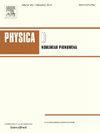On the constructivity of the variational approach to Arnold’s Diffusion
IF 2.7
3区 数学
Q1 MATHEMATICS, APPLIED
引用次数: 0
Abstract
The aim of this paper is to discuss the constructivity of the method originally introduced by U. Bessi to approach the phenomenon of topological instability commonly known as Arnold’s Diffusion. By adapting results and proofs from existing works and introducing additional tools where necessary, it is shown how, at least for a (well known) paradigmatic model, it is possible to obtain a rigorous proof on a suitable discrete space, which can be fully implemented on a computer. A selection of explicitly constructed diffusing trajectories for the system at hand is presented in the final section.
论阿诺德扩散变分法的构造性
本文旨在讨论贝西(U. Bessi)最初提出的方法的构造性,以探讨通常被称为阿诺德扩散(Arnold's Diffusion)的拓扑不稳定性现象。通过改编现有著作中的结果和证明,并在必要时引入额外的工具,本文展示了至少对于一个(众所周知的)范例模型,如何能够在一个合适的离散空间上获得一个严格的证明,并且可以在计算机上完全实现。最后一节介绍了为当前系统明确构建的扩散轨迹。
本文章由计算机程序翻译,如有差异,请以英文原文为准。
求助全文
约1分钟内获得全文
求助全文
来源期刊

Physica D: Nonlinear Phenomena
物理-物理:数学物理
CiteScore
7.30
自引率
7.50%
发文量
213
审稿时长
65 days
期刊介绍:
Physica D (Nonlinear Phenomena) publishes research and review articles reporting on experimental and theoretical works, techniques and ideas that advance the understanding of nonlinear phenomena. Topics encompass wave motion in physical, chemical and biological systems; physical or biological phenomena governed by nonlinear field equations, including hydrodynamics and turbulence; pattern formation and cooperative phenomena; instability, bifurcations, chaos, and space-time disorder; integrable/Hamiltonian systems; asymptotic analysis and, more generally, mathematical methods for nonlinear systems.
 求助内容:
求助内容: 应助结果提醒方式:
应助结果提醒方式:


